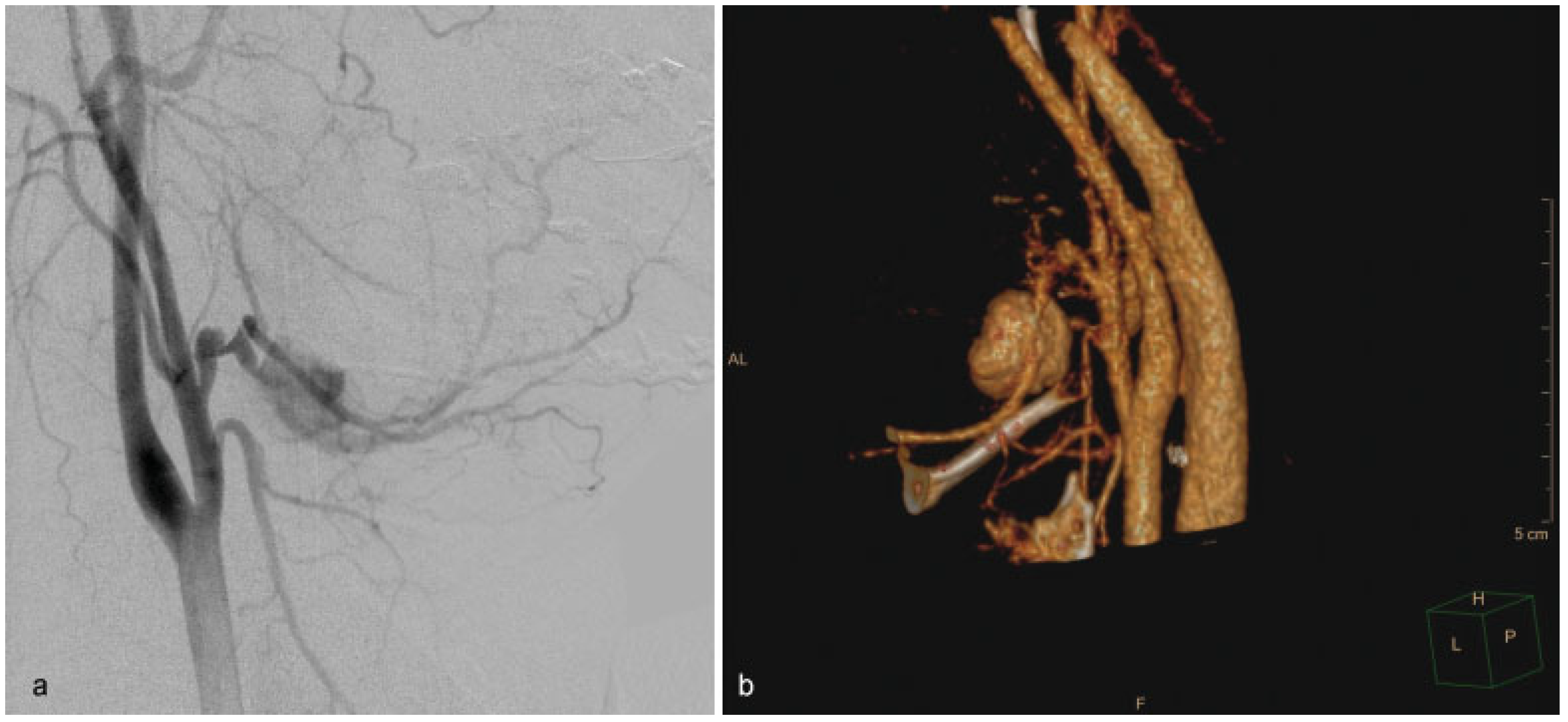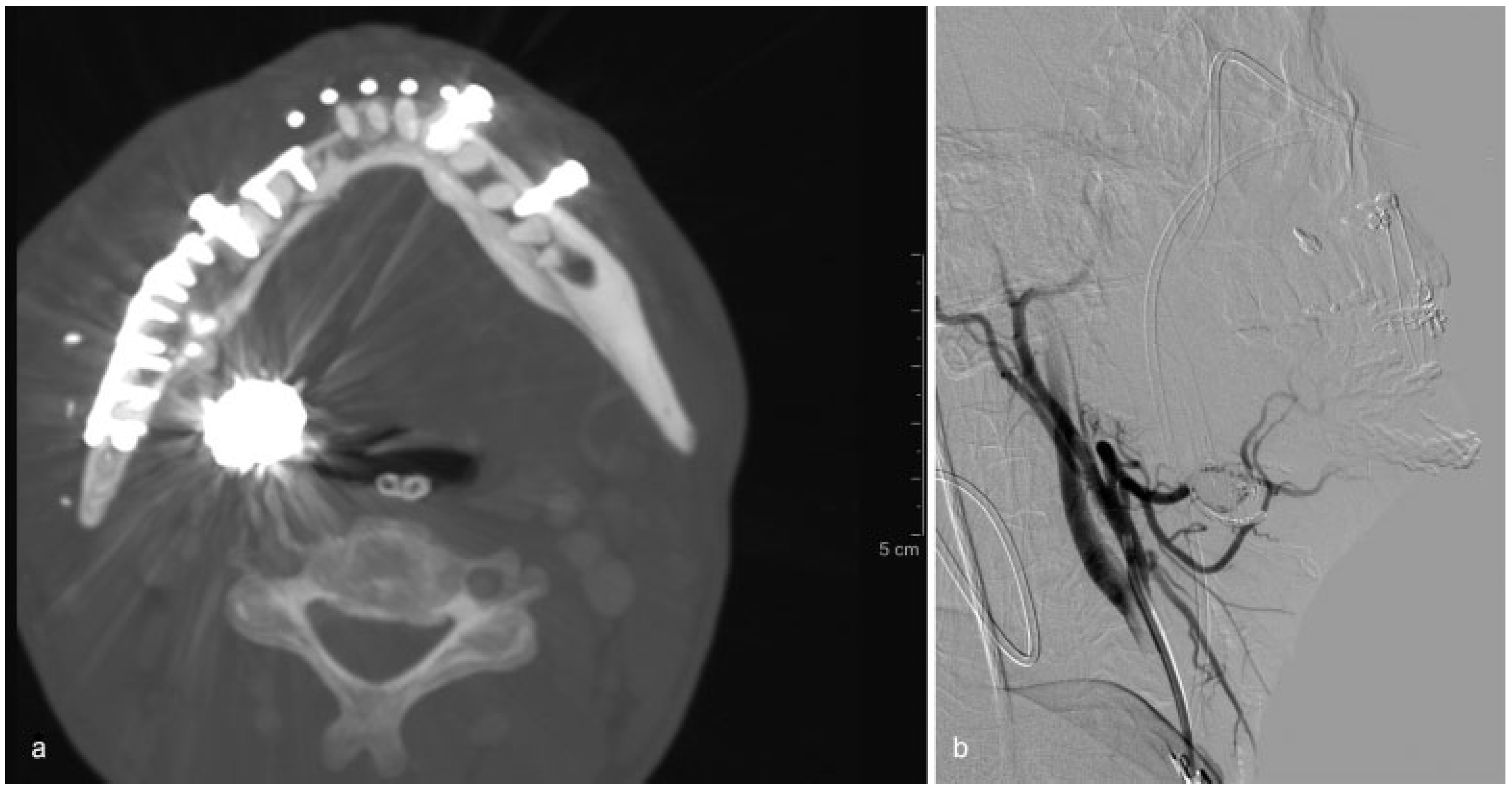The mortality associated with high-energy trauma has several time peaks. Prognosis largely depends on the extent of injury and events in the classical “golden hour.” In the particular case of isolated head and neck trauma, management initially includes stabilizing the patient, especially the airway and circulation, and then proceeding to treat injured structures with debridement and often fracture fixation and coverage. However, significant late complications can occur, such as life-threatening bleeding.
We present the case of a male patient who suffered a severe facial trauma at his workplace (
Figure 1a). He underwent an initial uneventful emergency surgery for control of bleeding and mandibular osteosynthesis. At 2 weeks postoperatively, a second emergency surgery was required to treat a previously undiagnosed lingual pseudoaneurysm that ruptured spontaneously, with massive oral bleeding.
An aneurysm is an abnormal dilatation of all three otherwise intact layers of the arterial wall. A pseudoaneurysm, or false aneurysm, is an abnormal blood vessel dilatation in which the injured vessel wall structure is replaced by fibrous tissue. Instead of being encompassed by the tunica intima and media, the lumen of a pseudoaneurysm connects directly to the adventitia or adjacent fibrous tissues, forming an encapsulated hematoma.[
1] With time, clot liquefaction and restoration of flow can occur, but there is also potential for significant bleeding, especially in posttraumatic cases.
Several authors have described such pathologies. Dediol et al. described a rare case of facial artery pseudoaneurysm outside the context of trauma, showing potential for pseudoaneurysm formation at this site, which more often presents with total transection of the vessel wall. The authors reviewed the steps in pseudoaneurysm formation, with extravasation of blood, tamponade, clot formation, and findings of perivascular fibrous tissue.[
2] Ribeiro et al. described a penetrating lingual artery injury confirmed by computed tomography (CT) angiography and managed with surgical ligation and evacuation of hematoma.[
3] In the setting of surgically treated mandibular condyle fractures, Ribeiro et al. described delayed presentation of an external carotid pseudoaneurysm at 4 weeks, confirmed by CT angiography and treated with ligation and drainage.[
4] Another case report emphasized the possibility of pseudoaneurysm as a late complication of facial trauma, with ligation as the treatment.[
5] Notably, our case emphasizes the surveillance and high index of suspicion required to best treat such high-energy head and neck trauma patients along their recovery, as well as the potential role of interventional radiology in these surgical patients.
Case Presentation
A 45-year-old otherwise healthy male patient was brought to the emergency room following facial trauma at his workplace. The patient had been struck on the right hemiface by the hook of an industrial chain and lost consciousness. The helicopter medical team performed a cricothyroidotomy to secure the airway, and the transferred patient was managed and stabilized by the emergency physician according to our trauma protocol. On arrival, massive arterial and venous bleeding from the lower facial third and oral cavity was temporarily controlled with compression. A facial CT scan showed a severely comminuted, displaced right mandibular fracture and associated hematoma (
Figure 1b,c). The head CT was negative for intracranial bleeding or fracture. The patient was urgently taken to the operating room to stop the facial bleeding, washout and debride the injury site, open reduce and internally fixate the mandibular fracture, and provide soft-tissue coverage with local tissue.
Intraoperative details included the application of Arch bars and mandibular fixation of all fracture fragments with a 2.0-mm reconstructive plate. Dentoalveolar fractures were meticulously fixated with miniplates. Occlusion was restored. Intraoral lacerations, including a significant tongue injury, were repaired. The patient was admitted to the ICU postoperatively.
The immediate postoperative course was uneventful, until unprovoked massive intraoral bleeding on postoperative day 14, required an urgent return to the operating room. After initial control of bleeding, the patient underwent intraoperative angiography that diagnosed a 25-mm pseudoaneurysm arising 10 mm distal to the origin of the right lingual artery (
Figure 2), which was superselectively embolized with coils by the interventional radiologist (
Figure 3). The patient was stabilized and was discharged from hospital 3 weeks later (
Figure 4).
Final angiographic controls showed complete occlusion of the pseudoaneurysm without immediate complications. The following postoperative period elapsed uneventfully.
Discussion
Pertinent Anatomy
Pseudoaneurysm occurs as a consequence of the partial rupture of a blood vessel with blood leakage into surrounding tissue.[
4] The surrounding tissue forms a fibrous aneurysmal sac working as the new vascular pseudo “wall.” While hematoma liquefies and blood flow is restored, the risk of life-threatening bleeding after aneurismal sac rupture increases.[
4]
Pseudoaneurysms of the extracranial carotid system are extremely uncommon.[
6] External carotid artery (ECA) branches are cushioned from injury in most locations by soft tissue. Nevertheless, vessels crossing over bony structures mostly remain vulnerable, such as the facial artery, the superficial temporal artery, and the superficial branches of the internal maxillary artery. The remaining branches of the ECA are protected from trauma by the facial skeleton.[
7] The lingual artery is one of the three anterior branches of the ECA. The lingual artery runs between the superior thyroid artery and the facial artery, and passes underneath the hyoglossus muscle after dividing into dorsal lingual artery and deep lingual artery. The lingual artery supplies the tongue, sublingual gland, and surrounding muscles of the floor of the mouth. Contralateral lingual and facial arteries provide compensatory perfusion to the tongue, allowing safe ligation of the ipsilateral lingual artery. Its path is generally protected from trauma, and subsequently also has a difficult surgical access.
Diagnosis and Imaging
Our case describes a traumatic pseudoaneurysm of the right lingual artery, presenting with rupture and life-threatening bleeding 2 weeks postoperatively after urgent initial oral and maxillofacial surgery. High-energy facial trauma, in our case with marked mandibular comminution, sets a plausible context for pseudoaneurysm formation. This case illustrates the importance of vigilance to and recognition of such a vascular injury.
Pseudoaneurysms most often arise after vascular trauma and can have late presentation. They may result in asymmetry, neurological defects, secondary hemorrhage, and release of thromboemboli.[
8] Their progression and onset of presentation depends on the arterial defect and the nature of the adjacent tissues.[
9]
In our case, retrospective analysis of the initial facial CT was inconclusive because contrast was not administered due to technical problems. Consequently, it was not possible to determine if a vascular insult was initially present at the time of trauma, which progressed to a ruptured pseudoaneurysm 2 weeks postoperatively. The literature confirms that most pseudoaneurysms are detected weeks after the trauma. Some authors such as Conner et al.[
7] described 2 to 4 months, others such as de Lucas et al.[
9] described between 1 and 8 weeks.
Several imaging modalities exist to diagnose vascular pathology. Angiography is considered the gold standard[
10] for the diagnosis and characterization of pseudoaneurysms with very high spatial resolution and the ability to study parent and potential collateral vessel selectively. Alternatively, CT angiography (CTA) can diagnose arterial injuries in the head and neck with high sensitivity and specificity and it is probably the most available and effective imaging diagnostic test in the emergency room.[
10] However, CTA is less sensitive in the facial region due to dental artifacts. Magnetic resonance angiography may substitute for CTA in some settings, but it is less available and more time consuming.[
10] Ultrasound diagnosis can be helpful, thanks to the characteristic sonographic appearance of pseudoaneurysms with an anechoic sac on gray-scale imaging and conspicuous to-andfro blood flow on color Doppler.[
10] Unfortunately, ultrasound diagnosis at the lingual artery is technically demanding due to its deep location, and even more so in the trauma and/or postoperative patient. Cox et al.[
11] presented 11 battlefield patients initially screened with CTA supplemented with conventional angiography or duplex ultrasound depending on the clinical situation. In the case of a patient with a lingual pseudoaneurysm, selective injection of the lingual artery was necessary to fully visualize the pseudoaneurysm not imaged in the initial carotid angiogram.[
11]
Treatment
Treatment of pseudoaneurysms is generally considered mandatory because of their unstable wall and tendency toward expansion and rupture. Historically, treatment has been surgical, with isolation and ligation of source vessels, with or without excision of the pseudoaneurysm itself.[
8] Image-guided percutaneous and endovascular intervention has largely overtaken surgical repair as the first-line treatment of pseudoaneurysms. The endovascular approach to pseudoaneurysm treatment is guided by the parent vessel (expendable vs. nonexpendable) and the characteristics of the pseudoaneurysm itself (wide neck vs. large neck).[
10] Although pseudoaneurysms may occasionally be readily surgically accessible, they are more typically located deep within heavily traumatized structures of the face and neck,[
11] as in our reported case.
Endovascular therapy is an attractive and modern approach. Like all procedures, it does have certain disadvantages, as it requires skilled and experienced interventional radiologists.[
12] The incidence of embolization-related complications is much greater than those related to surgical treatment and include necrosis, infection, and detachment of the embolus into the blood flow.[
5] The various collaterals between branches from external and internal carotid artery may result in embolus being propelled into branches of internal carotid artery with dangerous sequelae.[
12] Catheter-induced vasospasm is a common difficulty encountered with superselective catheterization of the ECA.[
13] Brisk hemorrhage after puncture of the pseudoaneurysm wall or incomplete occlusion after coil embolization may occur during transcatherization.[
12]
Nevertheless, the great advantage of embolization is the occlusion of the proximal and distal vessels to the injury. The more distal the catheter placement, the safer and more effective the embolization but, unfortunately, the greater the chances of vasospasm being induced.[
13] In the face,[
5] the large number of anastomoses often maintain blood flow beyond the zone of injury and embolization. Endovascular technique thus can improve the access to surgically inaccessible vessels and reduces the need for general anesthesia[
5,
12] and the primary treatment modality in many centers.[
12]
Conclusions
Pseudoaneurysms need to be considered in high-energy trauma patients, despite their delayed presentation, and can be life threatening if ruptured. Angiography is considered the gold standard for the diagnosis and characterization of pseudoaneurysms, while standard CTA is the most available diagnostic tool in emergency rooms. The interventional endovascular approach provides safe and effective treatment for pseudoaneurysms, especially those located in deep anatomical areas, such as those of the lingual artery.






